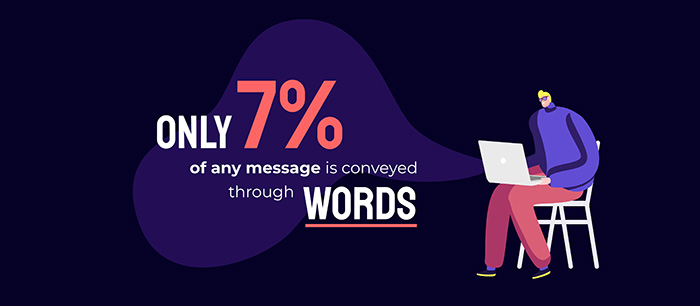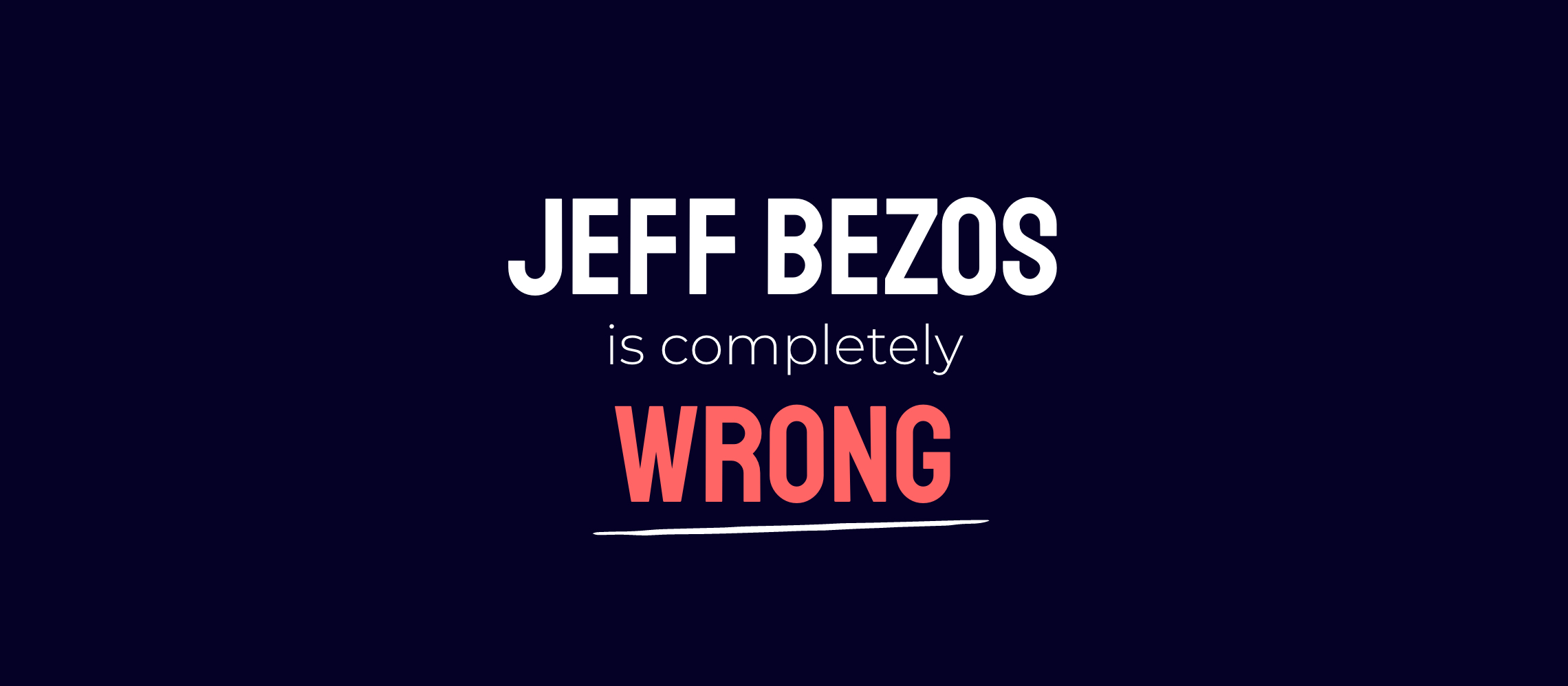The Amazon CEO’s objective makes sense, but his solution is misguided
We’ve all heard the phrase “a bad workman blames his tools”, and we’ve probably all shouted at a piece of machinery for not doing its job properly, despite being totally to blame.
Well it seems like for the rich and famous, going on a tirade of media appearances to muddy the name of the humble spanner or hammer is a lot easier than learning how to use it.
Jeff Bezos famously emailed his senior team in 2004, informing them that PowerPoint was out, and “written narratives” were in.
We don’t do PowerPoint (or any other slide-oriented) presentations at Amazon. Instead, we write narratively structured six-page memos.
Jeff Bezos

By “written narratives”, Bezos was referring to six-page memos that were to be prepared on each and every subject matter raised in team meetings. Since this initial instruction, Bezos has spoken widely about his aversion to the presentation software, and many others have aired their similar opinions, from University professors to Army Commanders.
Bezos had obviously done his research. Science has long acknowledged that the human brain is more attracted to narrative formats when digesting information. But simply calling a document a narrative doesn’t guarantee an emotional connection. Bezos, obviously reaching his quota of mind-numbing presentations with slide after slide of unconnected bullet points, had landed on PowerPoint as the villain in this story, and vanquished it from his world.
But is banning PowerPoint entirely the smart move?
PowerPoint is extremely accessible, it’s easy to use, and yes, it does have a button to create bullet points. All of these factors can make users lazy. And that’s the real villain here: people have become so used to using PowerPoint a certain way that they don’t put effort into learning how to do it better.
What’s simpler and more time efficient than just giving up when something takes mental energy to understand? I find it hard to believe that this is the ethos Amazon is built on. This is the company that reinvented retail, so why not do the same for their presentations?
Next evolution of humans:huge thumbs and no ears
A study of 10,000 adults revealed that we are less likely to compromise than ever before. And that we’re more likely to make huge life decisions (such as where to live and who to vote for) based entirely on predetermined beliefs.
Both of these facts point to one conclusion: we are not listening to one another. With most communication happening over text, email and social media in our technology-driven modern world, these findings may not come as a surprise to most.
But compromise and outside influence are both hugely important when it comes to running a business. If it weren’t Bezos would be running Amazon by himself. His memo solution isn’t doing anything to reopen these lost channels of communication.
Listening is hugely important to communication. Dr Albert Mehrabian conducted multiple studies on non-verbal communication, and found that:
- Only 7% of any message is conveyed through words
- 38% is conveyed through vocal elements, such as intonation and
- 55% through non-verbal communication, such as facial expressions, gestures and posture.

So, by eliminating the presenting element of a presentation, Bezos is denying 93% of his audience’s understanding.
Rather than focusing on the root of the problem, he’s simply shifting the problem from screen to printed page, and removing the key element of any story: the storyteller.
There is nothing more powerful, more engaging and more raw than hearing someone’s story out of their own mouth.
Take the time for telling stories
Asking his employees to write six pages of carefully-planned, evidence-based narrative is already a step towards creating an incredible presentation. The problem is that Bezos asks them to stop there, with walls of text on a page. The art of presenting comes down to separating that narrative into:
- what is said and
- what goes onto the slide in support of what is said.
Bezos wrote, “The great memos are written and re-written, shared with colleagues who are asked to improve the work, set aside for a couple of days, and then edited again with a fresh mind. They simply can’t be done in a day or two.”
And neither can a great presentation. So, we’re on the same page so far.
What Bezos is really asking his team to do, is to focus on crafting a story, to put time and preparation into their meetings, so that the narrative flows and is engaging. He just wants all the points to be carefully considered and backed up with facts, not just thrown on a blank slide in the form of bullet points. If Bezos understood the numerous benefits of visual accompaniments to a thoroughly-prepared narrative, he may be willing to see that the blame doesn’t lie in the software, but inthe training he’s giving his own team.

It’s all about image
If you search for any product on Amazon, right at the top of the page you’ll find a range of photos from various angles, aimed at assisting your purchasing decision. Scroll down considerably, and only then will you find the lengthy description. Bezos understands the power of visual support when it comes to his external-facing business, but hasn’t made the connection to internal team meetings.
Adding imagery, graphics, illustrations and iconography to your PowerPoint slides makes your message easier to understand, and easier to remember. Visuals also help to break down cultural and language barriers, as easily-recognisable, universal symbols for communication.
However, Bezos’ text-heavy memos are building barriers instead.

The great divide
Across any company, there are numerous types of learner. Some people prefer to read, some people take information in better when they hear it, and some are visual, image-based learners. PowerPoint presentations open up the possibility for all to understand, by combining all these methods of learning. Print documents are only directed at one type of learner, immediately alienating anyone who doesn’t fall into this category.
And what about people with dyslexia? Are they not welcome in the executive ranks at Amazon? Using images and diagrams to support text, considering text layouts, and adding video to presentations can all help people with dyslexia to comprehend and feel included. Large blocks of heavy text will immediately put them at a disadvantage and make them feel uncomfortable.
In fact, Bezos’ memos could alienate more people than you’d think. Executives on the autistic spectrum will also find it hard to engage with walls of text and these learners actually prefer simple sentences and, you guessed it, bullet points.
PowerPoint is an inclusive tool for learning and communication, but a team that hasn’t been given the training or tools they need to use this software creatively, will continue to churn out the same infuriating presentations.
Moving and shaking
It’s not just Jeff that is making his views on PowerPoint known. University teachers are jumping on the Bezos bullet point bandwagon too. Bent Meier Sørensen, a professor of Philosophy and Business at Copenhagen Business School, is leading a revolution to remove PowerPoint from the classroom. One of Sørensen’s arguments is that PowerPoint stifles conversation, eliminating the possibility of improvisation or deviation from the pre-planned slides.
Well, Sørensen obviously hasn’t been keeping up with the Buffalo 7 blog, or he would’ve learned that there are many ways to add navigation and flexibility to your narrative timeline. A simple hyperlinked menu system allows your conversation to unfold naturally, so that you can engage with the audience and move your slides along in support, with just one or two clicks.
Non-linear presentations are a breeze to create with intelligent in-built tools, such as Zoom. You don’t even need to build your own menu systems anymore; Zoom will do it all for you. This means you can focus on having a real conversation with your audience, taking back control of your own presentation, and setting your own agenda.
Sørensen doesn’t seem to be a fan of animation either, stating, “a moot point doesn’t become relevant by moving in mysterious ways”, to which I ask myself, why are you putting moot points in your presentations? It might be time for Sørensen to revisit the storytelling part of his process, before he’s thinking about animating anything.
Animation comes at the very end of any Buffalo 7 project for a reason. Animation is the finesse, the emotion and a way to create clarity in complexity. But your presentation should be able to communicate without it. Your story should be strong, and your design should add clarity. Animation is just the pièce de résistance, elevating the whole presentation.
Think about Disney’s original The Lion King. Do you think the death of Mufasa would’ve had such a lasting impact on us all if we simply read the original script, or saw the draft, static storyboards? It’s the coming together of intelligent writing, incredible design and the life-giving magic of animation that creates the impact of that scene.
No compromise in the conference room
By confining his team to the written word, Bezos is creating exclusivity in his boardroom, and ignoring the many nuances of communication. What’s more, he’s allowing decisions to be made on existing opinions and without compromise. While the team are sitting in silence, reading through the six pages of proposal, they are forming their conclusions without hearing the presenter put their emotion and their soul into explaining their vision.
They are reading it in their own voices, and they are making decisions based on predetermined beliefs. No matter how convincing the answers to their questions in the later discussion period, their minds will already be made up.
If Bezos truly believes this to be the best way to communicate within his four walls, why not go one step further and give the executives time to produce their own six-page documents in response to every proposal? Surely, it’s only fair to allow them the time and headspace to form their own lengthy arguments and lay these out neatly in print. What’s stopping Bezos from banning face-to-face conversation altogether and only communicating through extensive written papers? The original Amazon – or any other rainforest – must be quaking in its roots.
We all need to be having more face-to-face conversations, in business and in our social lives, before we forget how. No matter how perfectly that gif you sent to your friend sums up your current ‘feels’, you are not allowing them to see the whole picture. And by removing his team’s ability to tell stories with all the tools at their disposal, Bezos is not painting a full picture of his business or the people within it.
Banning the bullet point
We’ve all, at one point or another, sat through a presentation that not only made us want to ban PowerPoint, but to find the guy that invented it and force him to endure every bad presentation that’s ever been made. But it’s not the gun that kills, it’s the person who pulls the trigger.
And it’s not the software that leads to ‘Death by PowerPoint’, it’s the guy behind the keyboard. Instead of ignoring the real problem, Bezos should encourage his employees to learn about all the incredible features within PowerPoint and give them the knowledge and tools to be more creative with it.
And, seeing as every argument we’ve read to oust PowerPoint comes back to this one gripe, perhaps it’s time Microsoft did ban the bullet point, and give these keyboard warriors no ammunition.


